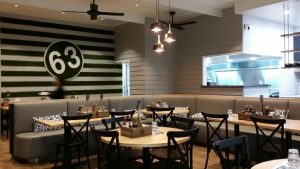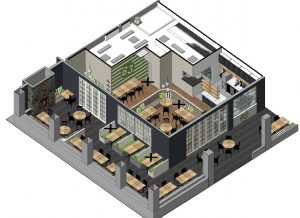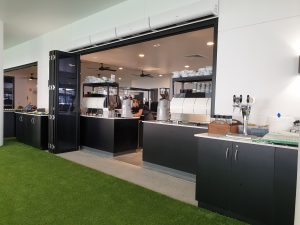Design Tips to Reduce Noise in Your Restaurant or Cafe
Every food establishment is unique in its requirements, with no two design briefs being identical. Noise is one such consideration that varies between each restaurant, cafe, pub, club and the like. Many clients want a soothing ambience that is conducive to relaxing and lengthy conversations, whereas others are keen to roll with the hustle that comes from loud music and big groups’ clatter and chatter. It depends on the client and their vision.
A complaint often levelled at food establishments is when the noise level doesn’t match diners’ expectations. Inappropriate noise levels may impact on customer experience. This could then results in negative reviews and feedback, which could hurt your business if not managed properly.
Additionally, some noise is good, while other noise is unnecessary, such as moving chairs, footsteps from other customers, conversations from the far side of the room etc.
When design impacts noise
Noise problems inside food establishments usually stem from the design and location of the restaurant itself. Sound bounces around commercial spaces, particularly with hard finishes, such as concrete floors, hard chairs, brick walls, hollow ceilings, etc. The industrial, modern and minimalist trends certainly don’t lend themselves to noise reduction.
Locations near busy streets with people walking and cars going by could also affect the noise levels inside your food establishment. When this situation arises, countermeasures should be applied to suit your establishment’s acceptable level of noise.
Controlling noise in your food business
If noise is negatively affecting your food establishment, it is possible to reduce the noise and sounds reflecting around your space. The following solutions are options considered by foodservice designers to manage noise levels.
1. Add soft furnishings
Soft furnishings reduce sound by absorbing din and echo, making it a simple, cost-effective way to address any noise issues. Options include dense fabric wall hangings, curtains, upholstered seating, tablecloths and cushions.
2. Consider window furnishings
Glass windows can be found in many establishments, which contributes to noise levels. Glass can significantly reflect sound, so window furnishings, such as curtains or blinds can mitigate sound being reflected or making its way in from outside. Alternatively, double glazing is another great option for reducing noise. If your food establishment is located near busy streets or inside shopping centres and shop frontage is important, double glazing may have a big impact.
3. Invest in better wall and ceiling panels
If you plan to renovate your establishment, it is better to invest in wall and ceiling panels with sound-proofing capabilities. You might experience unnecessary noise from neighbouring commercial places which may disrupt your customers. Investing in sound-proof panelling to block these noise inputs is worth every cent for customer experience.
4. Install soft flooring finishes
Installing soft flooring (or wall) finishes in high-traffic areas, such as the lobby, pathways, and bar can be beneficial in reducing noise levels. Carpets are known to reduce excess environmental noises inside the food establishment that might disturb other customers that are trying to relax and have a good conversation. For example, Cafe 63 is renowned for its use of green artificial turf throughout their cafes. Sometimes it is used on floors throughout, while other times it is used as a feature on walls. Not only has this become a signature feature in their branding, but the turf also has maximum noise absorption qualities. This obviously won’t suit everyone, but it’s a good example of how you can use noise-reducing ideas to your advantage and really ‘own’ the look in your establishment.



5. Add soft feet to mobile furniture
If you opt for hard flooring, consider adding rubber or soft feet to stools, chairs and other mobile furniture to prevent loud scraping and banging when they are moved around by customers. During peak times, this simple trick can help keep noise at an acceptable level.
6. Maintain airconditioning, ventilation and heating systems
Heating, cooling and ventilation systems can also contribute to noise levels, particularly when they are not operating efficiently. It’s important to invest in quiet systems wherever possible. The key is to conduct regular, thorough servicing and maintenance to prevent these systems from working too hard and emitting loud whirring or other noises.
7. Work with a closed kitchen
Some restaurants and cafes opt for open kitchens, while others prefer to keep the kitchen away from diners’ view. If kitchen noise is becoming an issue, consider closing off the kitchen to stop the clatter, equipment noises and back-of-house banter spilling out into the front-of-house area.
8. Setup a proper sound system
Music is considered essential to food establishments as a form of entertainment for guests enjoying their food and conversations with friends and family. A properly placed sound system. such as high-quality speakers on different corners of your restaurant is important in reducing centralised music situations. However, it’s important to consider seating arrangements and where sound is going to bounce or channel along hard walls or ceilings.
Investing and creating an environment where customers can have the best dining experience possible is essential for your business to grow. Positive customer experience helps retain previous customers and spread the good word to new customers. Noise is a key part of customer experience and shouldn’t be overlooked in your planning.
Consult a foodservice designer today for more information about keeping noise levels down inside your food establishment. Contact us today.
